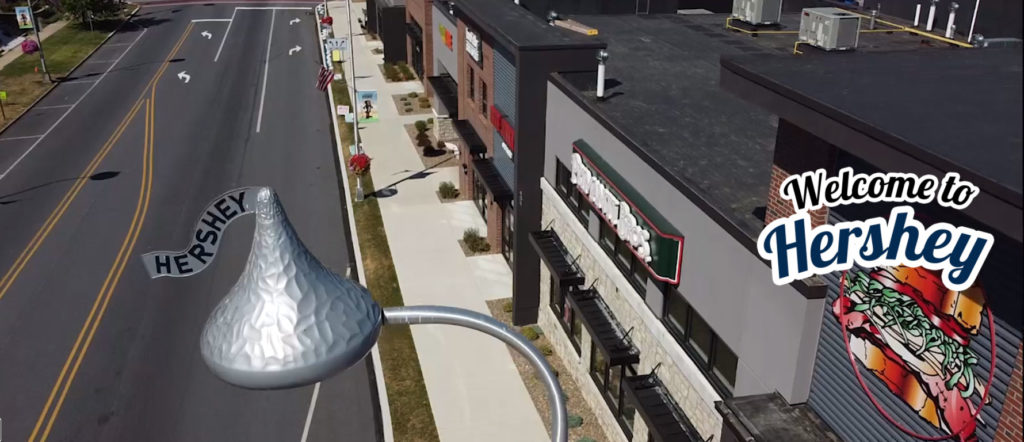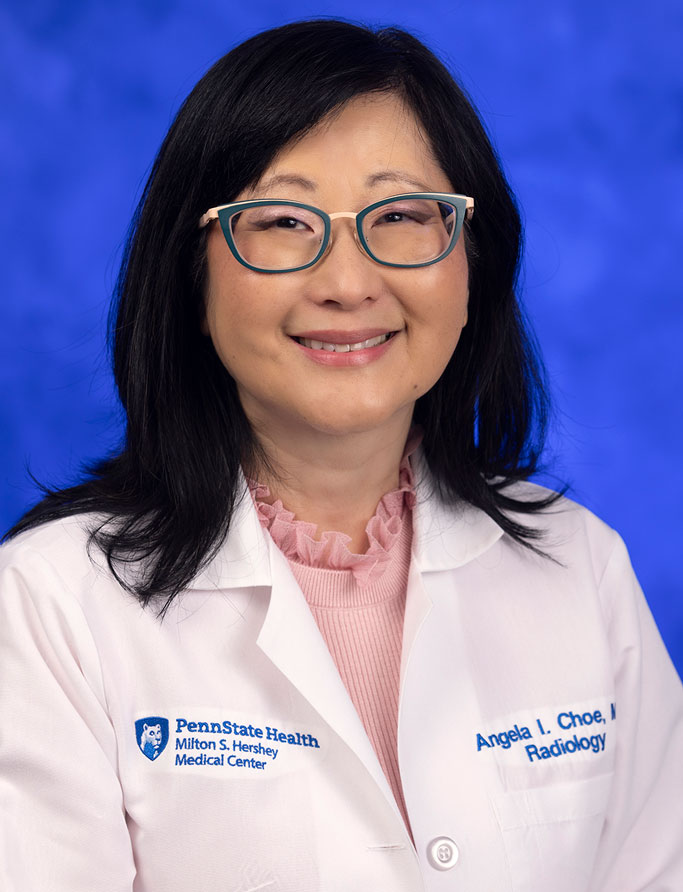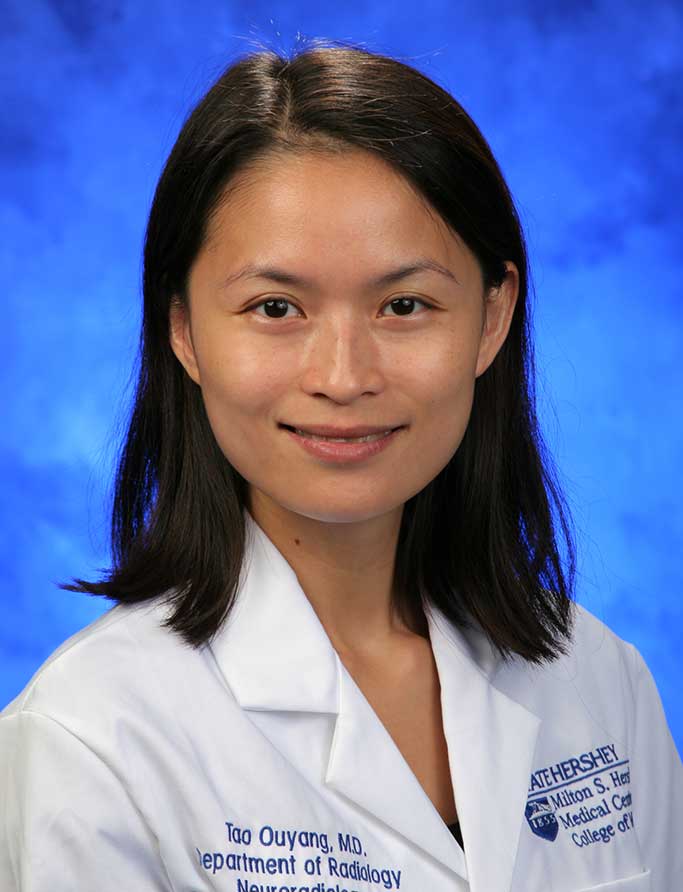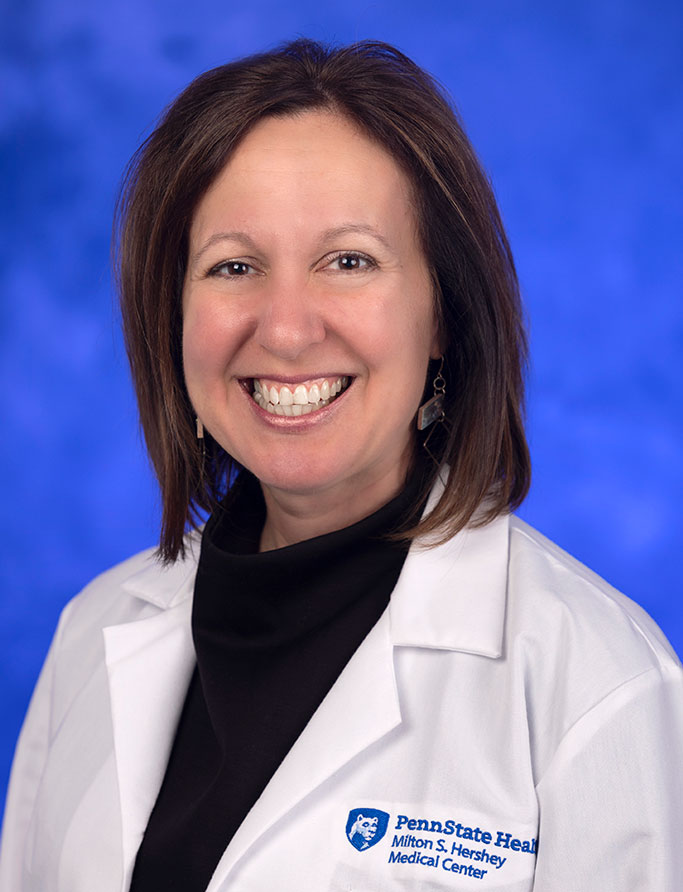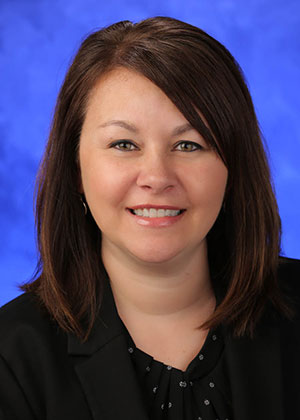Jump to topic
Search
Program Details
Goals
The goals of the Diagnostic Radiology Residency are for each resident to be able to:
- efficiently and accurately interpret diagnostic radiological examinations of all modalities and subspecialties;
- competently and confidently perform all diagnostic radiological examinations and procedures;
- efficiently and appropriately direct the radiological workup of common and uncommon clinical presentations;
- apply principles of radiation physics, radiation protection, radiation biology and quality improvement and assurance; and
- possess and apply the medical knowledge, critical thinking and clinical reasoning necessary to pass the Core Examination from the American Board of Radiology at the end of third year.
The fully accredited program fulfills the requirements for certification by the American Board of Radiology in Diagnostic Radiology.
Learn More about the Residency
Penn State Health Milton S. Hershey Medical Center offers a unique training environment from the typical U.S. academic medical center. The hospital is located in a thriving semi-rural area that is safe, friendly, active and beautiful.
As a major academic medical center for a vast geographic region, we serve many pivotal roles, including Level 1 trauma center and home to a nationally recognized Penn State Children’s Hospital and Penn State Cancer Institute. Thus, we provide a high case volume with a wide range of pathology for a diverse population. We have a very robust DEI program across the institution and in the Radiology department. We are committed to advancing diversity and belonging in recruiting residents and faculty.
The Penn State College of Medicine received a record-breaking $159.8 million (685 awards) in research funding in fiscal year 2023. The inspired work of our teams of investigators, trainees and our incredible research support staff who manage contracts, regulate biosafety, maintain equipment and many other critical tasks made this record‑breaking year possible.
Training is primarily at one location with short commuting times. Local elective educational opportunities are available. The resident salary is above the median income for the local area, and your money goes further in our community than in a typical major city.
The goal of the residency is to provide a supportive educational environment that optimizes resident education and wellness. Radiology faculty members partner with trainees in the daily workflow and are eager to guide residents as colleagues on their journey of lifelong learning.
Education is one of the highest priorities within the department, and we make decisions about the curriculum and rotational experiences based on educational needs rather than service requirements. Overall resident case volumes are challenging but appropriate, and as a result, our graduates are well-prepared for the rigors of fellowship training and clinical practice.
We are interested in recruiting residents who are passionate about learning and are dedicated to providing safe, high-quality patient care in a system that values respectful teamwork and collegiality.
We are… Penn State!
Angela Choe, MD
Program Director, Diagnostic Radiology Residency
General Application Information
Applications to the Diagnostic Radiology Residency are made through the Electronic Residency Application System (ERAS).
Candidates for residencies are considered during their fourth year of medical school and (rarely) during or after their internship, space permitting.
Interview Process
A personal interview is a requirement for admission. After initial selection of applicants based on completed applications, selected candidates are invited for interviews. Given the challenges presented by COVID-19, all interviews will be held remotely. More information can be found by clicking or touching the link at the top of this page.
There are 24 resident positions (usually six per year), filled through the National Residency Matching Program.
Selection Process
The program looks for smart students, but as importantly, seeks students who would fit in well in the culture of the program. The program’s culture is one of kindness to others, respect for others and humility. Self-motivation and perseverance are very attractive attributes as well.
Program Prerequisites
The residency is a four-year program (PGY-2 to PGY-5). All residents will need to complete a clinical year (PGY-1) of ACGME-approved training. This year must be accredited clinical training in internal medicine, pediatrics, surgery or surgical specialties, obstetrics and gynecology, neurology, family and community medicine, emergency medicine or any combination of these. This clinical year will usually be the first postgraduate year.
No more than a total of three months of this year may be spent in radiology, radiation oncology and/or pathology.
All clinical training must be in an ACGME-approved program.
Almost all graduating residents in recent years have pursued fellowship, with few exceptions due to financial reasons or military commitments.
Graduating residents have trained at world-class fellowships at many prestigious institutions. These have included Johns Hopkins University, University of California – San Francisco, Stanford, Brigham and Women’s University, Mayo Clinic, Thomas Jefferson University, New York University, University of Wisconsin, University of Virginia, University of Michigan, University of Texas, University of Wisconsin, University of Pittsburgh, University of Maryland and Penn State’s own fellowship programs in abdominal imaging, breast imaging, cardiovascular and interventional radiology and musculoskeletal radiology.
As is true in many residency programs, most graduates seek employment in a private-practice setting after fellowship. Several recent graduates joined the faculty at Penn State as either academic faculty or as part of the community practice division.
Virtual Tour
Penn State Health
Penn State Health is a multi-hospital health system serving patients and communities across 29 counties of Pennsylvania. Its mission is to improve health through patient care, research, education and community outreach.
In December 2017, the system partnered with Highmark Health to facilitate creation of a value-based, community care network in the region. The shared goal of Highmark and Penn State Health is to ensure patients in the community are within:
- 10 minutes of a Penn State Health primary care provider
- 20 minutes of Penn State Health specialty care
- 30 minutes of a Penn State Health acute care facility
Learn more about Penn State Health
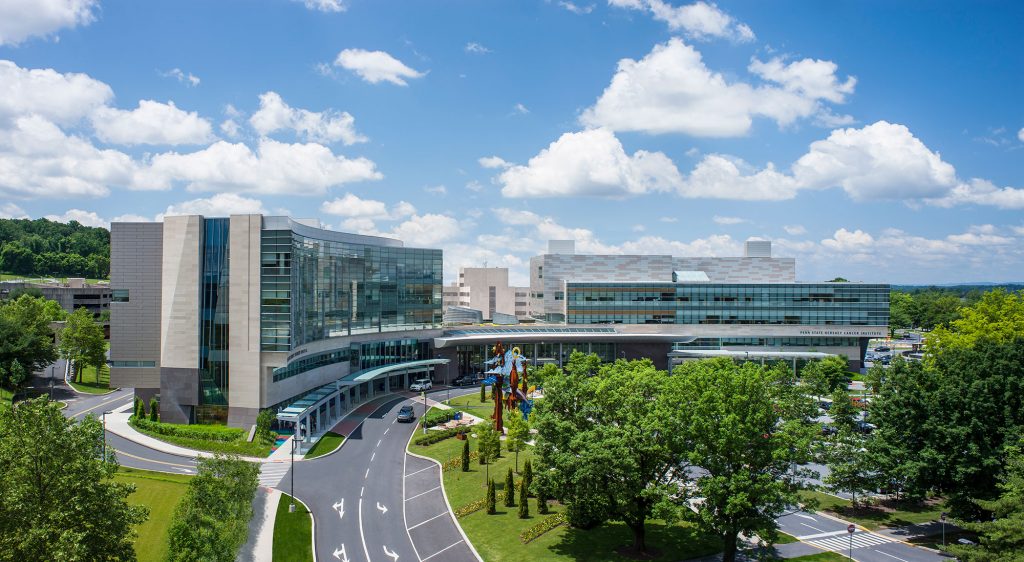
Penn State Health Children’s Hospital (left), Penn State Health Milton S. Hershey Medical Center (center) and Penn State Cancer Institute (right)
Penn State Health Milton S. Hershey Medical Center
500 University Dr., Hershey, Pa., 17033 (Derry Township, Dauphin County)
- The health system’s 647-bed flagship teaching and research hospital
- The only medical facility in Pennsylvania accredited as both an adult and a pediatric Level I (highest-level) trauma center
- Dedicated surgical, neuroscience, cardiovascular, trauma and medical intensive care units
- Accredited Life Lion critical-care transport providing more than 1,100 helicopter and approximately 750 ground ambulance transports per year
- More than 1,300 faculty members and more than 650 residents and fellows
- Approximately 29,000 admissions, 73,000 emergency department visits, 1.1 million outpatient visits and 33,000 surgical procedures annually
- Designated as a Magnet hospital since 2007
Learn more about Milton S. Hershey Medical Center
Penn State Health Children’s Hospital
600 University Dr., Hershey, Pa. 17033 (Derry Township, Dauphin County)
- An eight-story, 263,000-square-foot-facility built in 2013 and expanded in 2020
- 146 licensed pediatric beds, 18 acute care beds and a 56-bed neonatal intensive care unit
- Level IV (highest-level) neonatal intensive care unit
- Level I quaternary (highest-level) pediatric intensive care unit
- Level I (highest-level) pediatric trauma center designation
- Intermediate care unit
- Dedicated pediatric operating rooms
- More than 150,000 pediatric outpatient visits and approximately 5,000 pediatric patient discharges annually
Learn more about Penn State Health Children’s Hospital
Harrell Health Sciences Library
Residents have access to the state-of-the-art Penn State University Libraries system. As part of that system, Harrell Health Sciences Library, on the campus of Penn State Health Milton S. Hershey Medical Center, serves both medical center staff and the medical students that attend Penn State College of Medicine.
Through this library, residents have institutional access to more than 6.9 million books, almost 400,000 ebooks, 110,000 online full-text journals and more than 700 databases.
Other Facility and Area Resources
- Multiple places to eat, such as Starbucks, Au Bon Pain and multiple cafeterias and cafes
- Free parking, including two covered parking garages and multiple additional parking lots
- Housing options ranging from on-campus apartments to local rentals to the potential to buy a small house or condo
Welcome to Hershey
More About Hershey
Interested in learning more about living and working in Hershey, Pa.? See details here:
Wellness, including emotional, spiritual, social and physical health, is a crucial component to training and to becoming a professional, compassionate and resilient physician. Self-care is a skill which must be continually practiced and reinforced. Penn State College of Medicine and Penn State Health are committed to addressing wellness among residents and fellows, with multiple resources readily available.
Institutional resources
- Visit BeWell – a health program designed to support Penn State Health employees
- See Penn State College of Medicine wellness resources here
- Employee Health Care Concierge and Case Management Service
- Partners in Medicine
Moving to a new city with your family does not have to be stressful. Residency programs have assisted many significant others with finding employment. There is also a GME-Wide Partners in Medicine (PIM) group that offers networking opportunities as well as various social and community oriented activities. - The Doctors Kienle Center for Humanistic Medicine
- Active and easily accessed Office of Professional Mental Health
Graduate medical education resources
Program-Specific Resources
The Diagnostic Radiology Residency prides itself on an atmosphere of mutual respect, admiration and camaraderie among the residents and between the residents and attendings. This has significant impacts on resident wellness.
Institutional Resources
Penn State Health and Penn State College of Medicine celebrate, embrace and support the diversity of all patients, faculty, staff, students and trainees.
Office for Diversity, Equity and Inclusion
In keeping with this, Penn State Health has an active Office for Diversity, Equity and Inclusion with various programs, networks and resource groups, including:
- Talks and lectures on diversity, equity and inclusion through the Inclusion Academy
- Regular events on topics such as eradicating racism and creating a culture of inclusiveness
- Many Business Employee Resource Groups (BERGs), including:
- Disability Business Employee Resource Group
- Interfaith Business Employee Resource Group
- LGBTQ+ Business Employee Resource Group
- Military and Veterans Business Employee Resource Group
- Multicultural Business Employee Resource Group
- NextGen Business Employee Resource Group
Learn more about the Penn State Health Office for Diversity, Equity and Inclusion
Learn more about the College of Medicine’s Office for Diversity, Equity and Belonging
Office for Culturally Responsive Health Care Education
The vision at Penn State College of Medicine and Penn State Health is to equip learners with the knowledge, skills and attitudes they will need to provide culturally excellent health care and research for an increasingly diverse U.S. population. The Office for Culturally Responsive Health Care Education was formed to help meet that goal.
Learn more about the Office for Culturally Responsive Health Care Education
Office for a Respectful Learning Environment
In addition, the institution does not tolerate discrimination, biases, microaggression, harassment or learner mistreatment of any kind, and any concerns are immediately addressed by the Office for a Respectful Learning Environment.
Learn more about the Office for a Respectful Learning Environment
Network of Under-represented Residents and Fellows
The Network of Under-represented Residents and Fellows (NURF) is a group of diverse residents and fellows representing all specialties. NURF’s goal is to promote cultural diversity in the residency programs through community involvement, mentorship with diverse faculty, professional networking and support for the recruitment of diverse medical students into the residency programs.
NURF is sponsored by the Penn State College of Medicine Graduate Medical Education Office and the Penn State Health Office for Diversity, Equity and Inclusion.
Visiting residents from other Penn State Health Milton S. Hershey Medical Center programs are welcome in the radiology elective program as schedules and space permit. They should work with their chief residents to schedule available electives.
On or before the first day of the elective, they should contact the general radiology elective coordinator to introduce themselves and to provide the coordinator with appropriate evaluation forms from their home department.
Elective time can be as long a standard medical student rotation block (four weeks).
Because of the nature of their responsibilities and involvement, grades will generally be pass/fail.
Mailing Address
Diagnostic Radiology Residency
Penn State Health Milton S. Hershey Medical Center
Department of Radiology
P.O. Box 850, MC H066
500 University Dr.
Hershey, PA 17033
General Contact Information
Phone: 717-531-6896
Fax: 717-531-0922
Curriculum Details
The four-year Diagnostic Radiology Residency consists of a core curriculum including image interpretation and procedural instruction in all radiologic subspecialties. Schedules permitting, junior residents are usually paired with more senior residents during each rotation, promoting important peer teaching skills and resident camaraderie and rapport.
Rotations are divided among the major radiology subspecialties, based on organ system and/or imaging modality (see below). All procedures and image interpretations are performed under the supervision of, and in cooperation with, an attending radiologist.
Rotations are in five-week blocks to allow for flexibility in scheduling rotation time around vacation and call responsibilities throughout the academic year.
Fourth-year residents concentrate on three specific subspecialties within radiology, consisting of approximately 12 weeks each. Fourth-year residents also have a dedicated four-week block for procedures, consisting of ultrasound- and CT-guided biopsies and drain placement. Additionally, fourth-year residents complete nuclear medicine and breast imaging weeks to fulfill the requirements for graduation if not already selected as a concentrated three-month block.
The first five weeks of the first year of the program consists of a dedicated orientation curriculum designed specifically for the first-year residents.
This program serves to teach incoming residents the policies and procedures of the Department of Radiology as they gain a practical overview of departmental operations and protocols.
First-year residents spend one-week rotations in each of chest, musculoskeletal, pediatric, body imaging and neuroradiology, working closely with their senior resident colleagues, technologists and faculty.
The orientation includes presentations and workshops with an emphasis on basic radiologic principles, the importance of a systematic approach to a radiological study and the basic workflow and procedures within each division.
This orientation is an excellent way for new residents to acquire an overview of how the department functions and an excellent opportunity to meet their departmental colleagues.
For the entire first year, there is a dedicated R1 curriculum consisting of a series of didactics and case conferences based on specific reading assignments.
These tutorials are conducted once per week on Friday mornings, and their emphasis is on providing a foundation of knowledge on which to build future expertise.
All residents attend the four-week course in radiologic pathology provided by the American Institute for Radiologic Pathology during their third year of residency.
Given the challenges presented by COVID-19, this opportunity will be offered virtually for the foreseeable future.
Tuition for this course (currently $1,900) is paid by the Department of Radiology. The resident’s salary is continued during this four-week course.
Several types of educational events are available to trainees in the Diagnostic Radiology Residency.
Didactic Conferences
Daily conferences occur from 11:45 a.m. to 12:45 p.m. each weekday. Attendance to these and all other conferences described here is required by all residents. All of the subspecialty topics that are included in the ABR Core Examination are covered during these conferences. Each lecture is given by a faculty member who is an expert in that field. Each subspecialty educational coordinator creates a curriculum that spans approximately two years, so that any given rolling four-year residency experience, the trainee is exposed to the full lecture curriculum twice.
Medical Physics
A comprehensive medical physics course is an integral component of the curriculum as well, designed and administered by the experienced Health Physics staff of Penn State Health Milton S. Hershey Medical Center. All residents attend these lectures, which occur twice per month.
Non-Interpretive Skills
Additional lecture series are also woven into the daily didactic conference schedule. These include curricula on ethics in radiology, the business of radiology, imaging informatics, diversity and inclusion, residents as teachers and research topics.
Interdisciplinary Conferences
In addition to didactics, numerous interdisciplinary conferences occur within each division of the Department of Radiology in cooperation with other clinical services. These include pediatric surgery and the pediatric specialty of neonatology, pulmonary radiology, ENT, angio-interventional, neurology/neurosurgery, rheumatology, musculoskeletal oncology, nuclear medicine/hematology malignancy, thyroid cancer and various tumor boards, including those for breast and liver/pancreas/foregut malignancies.
Visiting Professor Program
Each subspecialty division in the Department of Radiology has the opportunity to invite one visiting professor to lecture to the residency each academic year. It is an outstanding opportunity for the residents to meet these distinguished academicians. Each visiting professor presents two conferences – one didactic and the other case-based. Residents are excused from clinical duties to attend these presentations.
Resident Lecture
Second- and fourth-year residents prepare and present a lecture to their peers each spring, guided by a faculty mentor of their choosing. These presentations not only form part of each resident’s evaluation but are a consistently enjoyable and valuable part of resident education.
Medical Student Lecture
Interested residents can participate in medical student education within the department to present one or more lectures, as part of a monthly lecture slot, to third- and fourth-year medical students on the radiology elective within the College of Medicine.
National Meeting Attendance Policy
Each second-year resident is encouraged to attend a one-week scientific national meeting within the contiguous United States. A generous stipend is provided to offset registration and travel expenses. Due to the challenges of the global COVD-19 pandemic, these meetings may be virtual in the future; however, all expenses required for registration will be covered.
Third-year residents are given 20 working days to attend the AIRP four-week course. Residents presenting papers or exhibits at regional and national meetings are also funded to attend.
Scholarly Project
All residents are required to complete a scholarly project during their residency. This may take the form of hypothesis-driven research, a case report, a scientific presentation or an educational poster. Resident research is strongly encouraged, though not mandatory. Research opportunities are available in each division of the department, and faculty are eager to work with residents on research projects.
Center for NMR Research
Residents have access to the Department of Radiology’s Center for NMR Research, which has 6,500 square feet of laboratory space, including biochemical and electronic equipment and a fully equipped machine shop.
A new 7T research magnet has recently been installed, with full-function MRI capabilities.
In addition, the NMR Research facility has a Bruker AM-400 WB NMR spectrometer with micro imaging accessory upgraded with a Tecmag Apollo console; an Oxford 1.9 Tesla, 26 CM bore magnet with Tecmag Apollo console; and a Bruker S-300, 90 cm bore, 3.0 Tesla whole body MR spectrometer/imager with Advance digital electronic and Paravision software.
Examples of work in the Center for NMR Research include memory and aging, functional MRI and novel MRI sequence development.
Learn more about the Center for NMR Research
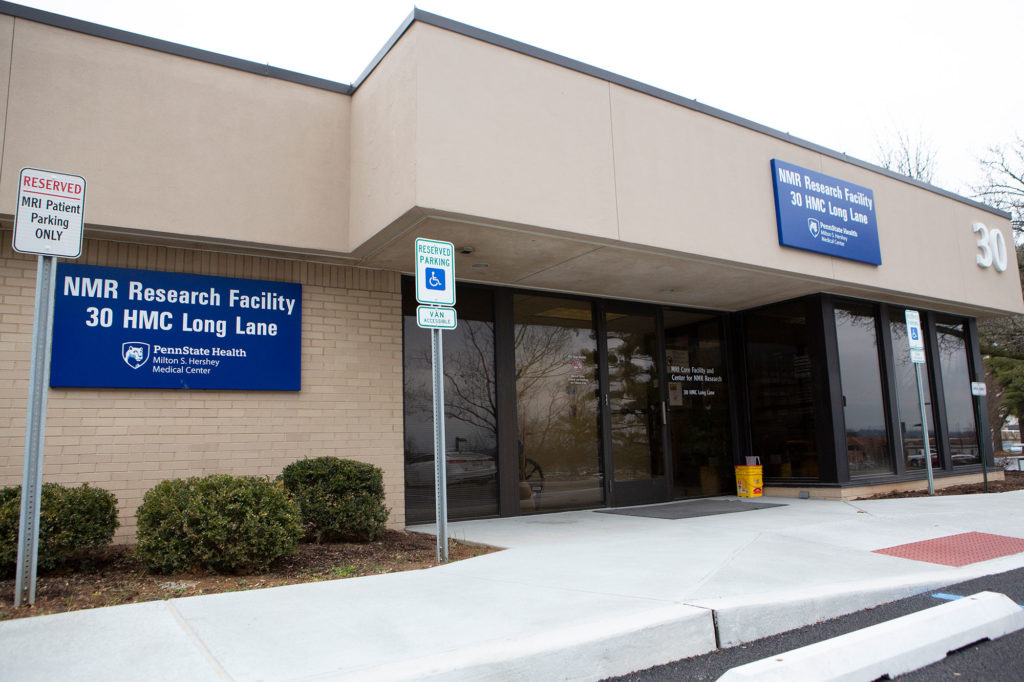
Center for NMR Research, Hershey, Pa.
Dr. Alison Chetlen has created a comprehensive and interactive curriculum for medical students rotating through radiology both from Penn State College of Medicine and other medical schools.
Dr. Pam Brian is heavily involved in medical student education for Penn State College of Medicine’s University Park Curriculum in State College, Pa., and is co-director of the pre-clinical gross anatomy course.
Dr. Chetlen runs several medical student electives, including general radiology, advanced radiology and special topics electives. Dr. Jim Brian runs a popular pediatric radiology elective. Dr. Jonelle Thomas and Dr. Angela Choe also run ongoing career-exploration third-year medical student electives within the department.
Diagnostic radiology residents have the opportunity to regularly or occasionally lecture to rotating third- or fourth-year medical students. With questions about medical student rotations, email Laurie Shearer at lshearer@pennstatehealth.psu.edu.
There are many other opportunities to pursue with the Department of Radiology and beyond for those interested.
For example, interested applicants, and even current residents, may pursue additional residency tracks, including early specialization in interventional radiology (ESIR) and combined nuclear medicine and diagnostic radiology (NM/DR) pathways, space and schedules permitting.
Since the program is part of Penn State, opportunities are also available to pursue a Master of Public Health, Master of Business Administration or Master of Education during residency as well.
The program participates in RAD-AID and supports all approved international rotations. The program also offers the opportunity to rotate at the Lebanon VA Hospital during the fourth year, under the direct supervision of VA faculty.
Institutional policies apply in the Diagnostic Radiology Residency. Where required program-specific policies supercede those, they are listed here.
On-Call System
The current call system was developed by residents. All residents that are on call are supported by a faculty member who is actively engaged in completing the workload. On-call faculty members are incentivized to read up to 70 percent of the caseload independently to support the residents between 8 a.m. to 10 p.m. on weekends, and until 10 p.m. on weekdays. A designated faculty member is always available via pager or phone call during the overnight hours to support on-call residents as well.
Subspecialty faculty from the divisions of pediatric radiology and neuroradiology are also actively involved in their respective workloads both during daytime call hours and overnight. On-call faculty from interventional radiology and nuclear medicine are also available at all times via pager for consultation.
R1 Call
First-year residents take no overnight or primary independent call. A “buddy” system is operated for the first nine months of the year, in which a senior resident is on primary call, paired with a first-year resident. During this time, the first-year resident is primarily responsible for initial interpretation of all radiographs performed within the emergency department. Final interpretations are performed by the supervising attending.
Duty hours are from 5 to 8 p.m. weekdays, and on weekends from 10 a.m. to 8 p.m. The frequency of R1 call is one day per week and one weekend per month on average. During the final three months of the first year, the resident assumes greater call responsibilities within this supervised system (consisting of mainly cross-sectional imaging) to assist in their transition to primary call as a second-year resident.
R2, R3 and R4 Senior Call
A night float and night shift system is operated on a rolling schedule of seven consecutive nights to ensure efficient completion of responsibilities.
- Night shift call: 5 p.m. to midnight for seven consecutive nights
- Night float call: 10 p.m. to 7 a.m. for seven consecutive nights
The frequency of night shift or night float call (combined) is five weeks in each of the second, third and fourth years of the program.
Evening call, with primary responsibilities of interpreting inpatient examinations, occurs 5 to 8 p.m. weekdays, approximately 12 times per year.
Weekend call consists of one weekend day per weekend, once per month, from 8 a.m. to 5 p.m.
Interventional Radiology Call
For each five-week interventional radiology rotation, each resident takes at-home call for approximately one week for the interventional radiology service. The resident must be available by pager at all times during this week, including overnight, and is always under the supervision of an attending interventional radiologist. A call room is provided in the Department of Radiology..
Educational Allowance
Each resident is given a $4,000 education allowance for the four-year residency. This stipend may be used for books, educational software, professional meetings and so on. An additional reimbursement is provided for radiation-protection gear.
Moonlighting
Residents may work up to 10 hours per week performing extra clinical services (evenings, weekends, holidays) at approved facilities. Moonlighting must not conflict with resident training or educational assigned time and must be approved by the program director.
Third- and fourth-year residents may also take locum tenens jobs during vacation time. It is the responsibility of the resident to provide malpractice insurance during any locums. Any moonlighting duties count toward total duty hour restrictions.
Compensation
See the salary structure for resident stipends here.
In the Diagnostic Radiology Residency, all first-year residents are paid PGY-2 salaries regardless of previous experience. Traditionally, there has been a modest annual cost of living adjustment. It is a policy of Penn State that paychecks be directly deposited.
The Department of Radiology offers fellowships in radiology subspecialties after a formal radiology residency. Fellowships, one or two years long, are tailored to the background, capabilities and interests of the individual.
Fellowships include:
Resident Honors and Recognitions
Penn State College of Medicine and Penn State Health Milton S. Hershey Medical Center accept ongoing nominations for the Exceptional Moments in Teaching award.
The award, given monthly by the Office for a Respectful Learning Environment, accepts nominations from College of Medicine students who are invited to submit narratives about faculty members, residents, fellows, nurses or any other educators who challenge them and provide an exceptional learning experience. See more about the award here.
Previous nominees from the Diagnostic Radiology Residency are listed here. Click the + next to a nominee name to read their nominator’s comments.
The annual Resident/Fellow Research Day is held each year (with exception of during the COVID-19 pandemic) on and around the Penn State Health Milton S. Hershey Medical Center campus.
The intent of the event is to provide an opportunity for residents and fellows to showcase their research accomplishments to their peers in other clinical departments, as well as their colleagues in the basic sciences.
Learn more about Resident/Fellow Research Day here.
Previous presentations from the Diagnostic Radiology Residency are listed here.
Latest News from Radiology



